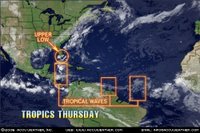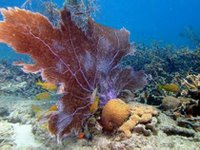An upper level system, extending from near Florida toward the southwest across the southeast Gulf of Mexico and into the northwest Caribbean Sea, continues to generate showers and thunderstorms from the U.S. southeast coast southwest into the northwest Caribbean. A surface low will devleop along a weak front moving into the southeast U.S. and become better developed near the Carolina coast later today and Saturday then lift northeast. We see no tropical development with this low. However, a tropical wave along 85 west near 22 north angles back south southwest into the northwest Caribbean. This tropical wave is interacting with the upper level system and this is leading to enhanced thunderstorms from western Cuba southward into eastern Nicarague and Honduras. Surface pressures in this area remain too high for possible development within the next couple of days and the wave is moving westward at about 7 to 8 degrees longitude per day. So, this feature will be over the Yucatan tomorrow, slow down and move into the southwest Gulf Saturday night and Sunday. There is a slight chance this system could organize in the far southwest Gulf of Mexico on Sunday.
Elsewhere in the Atlantic Basin a tropical waves along 60 west and along 45 west are moving west at about 15kts. Both waves are surrounded by African dust at this time. This dust will continue to suppress thunderstorm development in and around these tropical waves. A new wave is emerging off the African coast just east of 20 west. t too is surrounded by dust and the thunderstorms around it will probably diminish witin the next 24 hours as it heads west.
A large area of African dust covers the eastern Caribbean eastward across the tropical Atlantic. As we have been stating all week this large area of dust is creating a strong inversion which will continue to suppress convective development. Given no large scale shower and thunderstorm development it will be very difficult for any tropical development over the eastern Caribbean into the western tropical Atlantic for the next few days.


